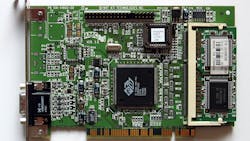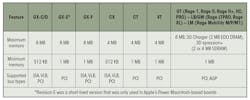ATI 3D Rage: One of the First "Free-D" Chips
>> Electronic Design Resources
.. >> Library: Article Series
.. .. >> Series: The Graphics Chip Chronicles
.. .. .. >> Introduction to this Series
.. .. .. << S3 ViRGE: Trying for Virtual Reality Too Early
ATI, founded outside of Toronto in 1985 as Array Technology, was a pioneer in the graphics-chip and add-in board (AIB) market. It was acquired by AMD in 2006 and formed what is now the Radeon Technology Group.
In late 1995, ATI announced its first combination 2D, 3D, and MPEG-1 accelerator chip with the name 3D Rage. The 3D Xpression AIB was based on its 3D Rage graphics chip and had elemental 3D acceleration, a year behind the pioneering Matrox Millennium PC 3D chip and around the same time as the S3 ViRGE.
Back then most graphics chip companies used coded numbers to designate a chip because it was just a component and branding wasn’t considered important. (Matrox was the exception).
ATI’s chips were distributed on ATI boards, and it was the 2nd largest graphics company in Canada behind Matrox.
Before 3D Rage, ATI had a chip called the Mach64. It was a 2D GUI, or Windows accelerator, and became popular on the Graphics Pro Turbo board. The chip numbers evolved from there: 264CT – 2nd generation Mach64 2D accelerator, 264VT – was the first ATI chip with video acceleration (V), and the 264GT – the first ATI chip with 3D acceleration (G), which was built with the team from Kubota graphics in Boston that ATI acquired.
As the COMDEX 1995 launch of the 3D Rage approached, ATI learned that S3 was planning to release its ViRGE 3D accelerator at the same time. Phil Eisler, the new chip's product manager, was not thrilled about launching a product called the ATI 264GT against it. So, he started searching for a name with some verve behind it to compete with the S3 ViRGE.
Back then ATI did have a small run of a 2D board product called the ATI Arcade Rage. Eisler appropriated the “Rage” part and changed the name of the 264GT and announced it at COMDEX 95 as the ATI 3D Rage.
The 3D Rage was a very versatile and scalable controller, and ATI made at least seven versions of it. It was one of the first graphics controllers to integrate the RAMDAC and clock synthesizer. The CT version had an integrated RAMDAC, and all versions had a VGA core.
The controller had support for all the popular busses of the time: ISA, VLB, PCI, and limited VESA VBE support. It had one-pixel shader, no vertex shaders, one texture mapping unit (TMU), and one raster-operations pipeline (ROP). The controller’s clock ran at 44 MHz.
The memory clock could run at 57 MHz and be overclocked up to 30% before the memory became unreliable. It had a 32/64-bit memory bus and could provide up to 456 MB/s bandwidth. It could support up to 8 MB of memory (16 MB for 3D Rage Pro).
The RAMDAC could generate up to 16.7 million colors (at 1280 × 1024 resolution) and 65,000 colors (at 1600 × 1200 resolution).
The chip was manufactured at SGS in a 500-nm process, packed 5 million transistors, and was supplied in a 90-mm package.
The 3D Rage represented a departure from the mach32/64 in that it was no longer register-compatible with previous ATI graphics accelerators or the 8514/A. (VGA register compatibility was retained, however.) This departure was necessary to resolve some design limitations that were a legacy of older generation chips. Fortunately, almost all the functionality that was in the mach32/64 was preserved in the 3D Rage design, and some useful additions and enhancements were incorporated.
The many variations of the 3D Rage family, the GX (first four columns), and the CT family are shown in the following table.
From a very rough architectural perspective, the 3D Rage family more closely resembles the mach32 than it does the mach64CT family. However, from a functionality and register level standpoint, the 3D Rage GX is almost identical to the 3D Rage CT. ATI made several versions of the AIB with TV video outputs and some AIBs had TV tuners on them.
Free-D
The price difference between 2D AIBs and 3D AIBs was so slight that the term “Free-D” became popular when describing them.
In late 1996, ATI started shipping its second-generation 3D Xpression PC 2 TV. The 3D Xpression board featured the company’s latest 3D Rage II chip as well as a new homegrown NTSC/PAL encoder chip called ImpacTV. Like its predecessor, the product was targeted at consumer multimedia applications. With the new TV output support, the board was suited for deployment in the family room where it could drive a big screen TV for playing games or recording digital video or animation to video tape. It was also suited for business settings where it could drive large-screen monitors for displaying presentations.
The company said at the time that the new device supplied around 20% better 2D performance, and twice the 3D performance of the original 3D Rage. That was accomplished by increasing the memory clock from 63 MHz to 73 MHz, boosting the size of the on-chip texture cache, and making pipeline improvements to increase concurrency. New features of the 3D Rage II were a 16-bit Z-buffer, and support for 4- and 8-bit palletized textures.
ATI supplied the chip with an integrated 170 MHz RAMDAC standard; however, the company was also able to screen for qualification at 200 MHz which they offered to OEM customers as an option. The 3D Rage II was fabricated by SGS in a 500-nm 5V CMOS process, and it was packaged in a 208‑pin PQFP. The following diagram shows the internal organization of the chip:
The ATI board also incorporated its ImpacTV TV encoder with a direct interface to the 3D Rage II chip. The 28-pin PLCC device communicated with the Rage II through the ATI Multimedia Channel (AMC) interface. The chip included a flicker filter and special circuitry to eliminate dot crawl. Both composite and S-Video output was provided, as well as SCART output for European component video systems.
The chip supported all NTSC and PAL formats and featured programmable timing to enable the correct signals to be generated from a variety of computer display modes, including legacy VGA modes and low-resolution DirectX game modes.
The 3D Xpression PC 2 TV had an estimated price of $219 (or around $375 today) in a 2 MB configuration. The ImpacTV chip was available for about $10 in OEM quantities. The 3D Rage II remained at about $30 (or slightly more than $50 today) in OEM volumes. ATI used a variety of silicon suppliers back then: SGS, NEC, UMC and eventually TSMC.
ATI had great success with the 3D Rage, so much so that IBM chose the 3D Rage for implementation on the motherboard of IBM’s Aptiva multimedia home PCs. It was the first announced 3D chip motherboard design win for the home entertainment market. Other companies like Sony and NEC followed suit. At the time, the company was averaging a million Rage chip shipments a quarter.
The Saga of ATI
ATI developed plenty of innovative and exciting technology over the years and rose to become the top supplier. However, the market for graphics solutions rapidly fragmented into the low-end and high-end gaming sector as well as the console gaming segment, the professional graphics workstation segment, and the commercial market. Several companies offered solutions for one of those segments, but by themselves the returns were not enough to sustain R&D and manufacturing costs. ATI recognized that the situation called for an economy of scale approach, a strategy similar to what Nvidia has done so successfully.
As a result, ATI acquired several companies over the years and helped write the history of graphics semiconductors.
Its first big acquisition, which caught the industry off-guard, came in 1994 when ATI picked up the design team from high-flying Kubota graphics, a leading-edge workstation supplier that had a long history of its own in acquisitions. And yes, it was the same Kubota that still makes heavy construction equipment. They ventured into computer graphics as part of a diversification program.
Then, in 1997, ATI picked up the assets of a once-leading PC graphics chip and board supplier, Tseng Labs. Tseng, like many other graphics chip suppliers at the time, struggled to make the transition to 3D. In the end, though, it wasn’t totally Tseng’s fault, though. It wasn’t so much that Tseng, or other companies couldn’t hire 3D graphics engineers who knew what to do and how to do it. They did. It was the unusually high investment in dollars and time that prevented the transition. ATI, Matrox, and S3 successfully shifted to 3D, and startups like 3Dfx and Nvidia rounded out the 3D graphics chip arena.
Chromatic Research, based in Mountain View, California, was founded in 1993 and announced its first product the same year—the Mpact media engine. Designed as a software-upgradeable multimedia processor, the device combined video, 2D graphics acceleration, 3D graphics acceleration, audio, FAX/modem, telephony, and videophone.
In October 1998, ATI acquired Chromatics Research. ATI had long wanted a Silicon Valley design center, and Chromatic had been looking for a big brother. Chromatics was one of the first highly integrated single-chip SoC suppliers.
In 1999, ATI again surprised the industry by acquiring part of Lockheed Martin’s Real3D team. (Intel acquired the other part). Real3D made ultra-high-end graphics for simulators and tried to parlay that expertise into the consumer market, but the parent company’s patience and checkbook waned over time.
The biggest move for ATI was when it acquired ArtX in February 2000, the ex-SGI developers of the Nintendo 64 and subsequent suppliers of Nintendo graphics chips. That propelled ATI into the console business. They had all almost the major market segments in graphics covered by this point.
On top of that, in March 2001, ATI acquired Fire GL (FGL), formerly a division of S3 (a different company than S3 Graphics) that became Sonicblue. FGL had been competing in the workstation market against 3Dlabs, Intense 3D (which was later acquired by 3Dlabs), HP and E&S. How did S3 get into the high-end workstation business? By acquiring a string of graphics companies.
By 1996, multi-monitors had become both practical and affordable, and they were considered essential by everyone from CAD engineers to Wall Street traders. But they were complicated to set up. A former graphics board maker, Appian Graphics, had distinguished itself by developing a robust and easy-to-use software driver that made multi-monitors less complicated. That was a feature ATI thought it should have. And so, in August 2001, ATI acquired Appian’s HydraVision desktop management software. ATI, and subsequently AMD, went on to be the leader in the multi-display market.
ATI’s next target was the integrated graphics market. The company had developed an integrated graphics controller (IGP), but it was impressed by the graphics chip designs coming out of Taiwan. Instead of taking the time to duplicate that work – a difficult investment in a fast-moving market – ATI chose to acquire it.
Television was another area where ATI wanted to expand. The company had been developing TV technology for some time, but to speed up the company’s capabilities and presence in what was seen at the time as a new multimedia system, it once again opened its checkbook. In February 2002, ATI acquired NxtWave which produced TV demodulators.
Another headline came across the wire in March 2006, reading, “ATI acquires Macrosynergy.” Macrosynergy was a division of the chipset firm XGI Technology, and ATI wanted it to expand its presence in China. As part of the deal, ATI absorbed 100 employees from the Shanghai-based company as well as an undisclosed number of engineers based in XGI’s Silicon Valley office.
However, ATI did not buy XGI outright, as had been rumored. In 2003, XGI was formed from the graphics division of SIS, the inventor of the IGC. ATI saw Macrosynergy’s international presence as a gateway into the burgeoning Chinese market. Trident was another one of the successful 2D graphics chip companies that couldn’t make the transition to 3D. XGI acquired Trident and UMC (a semiconductor fab in Taiwan), and then re-acquired SIS, a company it helped get off the ground.
Around 2002, mobile devices were starting to take off and several startups emerged with graphics co-processors for phones, PDAs, and other battery-powered personal devices.
Bitboys Oy was a graphics hardware development company based in Finland and founded in 1991. The company started selling a revolutionary high-end graphics chip that became the TriTech’s Pyramid3D. Unfortunately, the chip was a challenge to manufacture, leading to Pyramid3D disappearance soon after it launched. Bitboys, however, gained ground in the mobile phone market by adopting some of TriTech’s concepts into a portable device. The company ended up selling the technology to NEC, one of the major early players in the emerging phone market.
Portable devices were another application ATI wanted to conquer and, in May 2006, the company acquired Bitboys.
Shortly after, the story ended. In August 2006, AMD acquired ATI, picking up a company that had developed a graphics solution for every platform imaginable, ranging from handhelds and TVs to workstations and consoles – and everything in between.
>> Electronic Design Resources
.. >> Library: Article Series
.. .. >> Series: The Graphics Chip Chronicles
.. .. .. >> Introduction to this Series
.. .. .. << S3 ViRGE: Trying for Virtual Reality Too Early
About the Author

Jon Peddie
President
Dr. Jon Peddie heads up Tiburon, Calif.-based Jon Peddie Research. Peddie lectures at numerous conferences on topics pertaining to graphics technology and the emerging trends in digital media technology. He is the former president of Siggraph Pioneers, and is also the author of several books. Peddie was recently honored by the CAD Society with a lifetime achievement award. Peddie is a senior and lifetime member of IEEE (joined in 1963), and a former chair of the IEEE Super Computer Committee. Contact him at [email protected].





